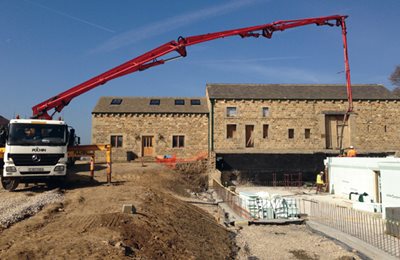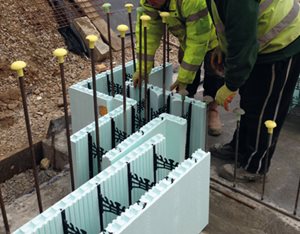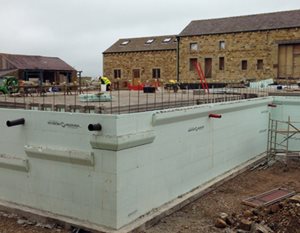Farmhouse basement, Yorkshire
2 May 2017
Overview
The Project
Yorkshire-based developer, Landmarks (UK) Ltd. has used insulated concrete formwork construction in the above-ground and basement construction of a traditional two-storey farmhouse. The property sits on a natural, gentle slope, so the basement is fully buried to the rear with a raised patio area to the front. The property was built using Nudura ICF, where polystyrene forms are used to contain the cast in situ concrete, with the polystyrene forms left in place as insulation.
Nudura ICF forms consist of two stay-in-place panels of expanded polystyrene, connected with an innovative folding web which minimises wastage and offers maximum flexibility. The forms are transported to site flat, opened and stacked, then reinforced and propped and ginally filled with concrete, creating a solid monolithic concrete wall.
Blocks are typically installed to a lift height to suit requirements and concrete is then poured into the forms. To ensure that no air remains within the void, the concrete is consolidated by means of a mechanical internal poker vibrator. As soon as the floor/roof is installed, wall building continues. The system is delivered to site folded flat to reduce distribution costs and allow for easy handling and storage. A sturdy four-way reversible interlock enables the forms to lock together, and waste is virtually eliminated.
Methodology
Using a number of Triton waterproofing products, the lower slab to the farmhouse was made waterproof by the installation of a membrane beneath it and the inclusion of an additive in the mix. This waterproofing agent contains active chemicals that react with fresh concrete to generate a non-soluble crystalline formation that seals the concrete against the penetration of water or liquid.

A pre-formed water bar, which swells by up to 350% when in contact with water, was placed into all joints. The shuttering around the slab made provision for the concrete groove in the face of slab and the bar was fixed into the groove using a mastic expansion sealant. The hydro-swelling and lasting adhesive properties of the mastic allow it to swell by up to 100% when in contact with water. The bar was also placed in the centre of the wall on top of the slab so the joint between the wall and slab was protected.
The waterproofing additive was incorporated in the concrete mix used to form the basement walls. The walls were filled in one day, with over 60m3 of concrete being pumped and consolidated with the mechanical internal poker vibrator.

All joints between the polystyrene panels were protected with a width of reinforcing fabric to give extra tensile strength. A fillet seal was trowelled into a wedge shape to the external toe of the concrete slab to ensure that any water flowed away from the joint – also protected with the fleeceband.
Externally, the basement walls were treated with two coats of vapour membrane; a ready blended, single component acrylic modified coating that provides a primary waterproof and gas proof barrier. The membrane provided a drainage and protection layer, which besides working as a traditional cavity drain to allow air movement between its face and the formwork, was then draped down the walls to connect to the land drain. The geotextile layer of the membrane was extended over the land drain to ensure that fines are kept out of the system. The external walls were then back filled.
Jon Rowlands, a director at Landmarks UK Ltd., explained “As Nudura ICF is suitable for both above ground and basement construction applications, speed of build really comes into its own. ICF buildings also offer limitless design possibilities, energy efficiency, acoustic performance, strength, minimal maintenance and repair.”
See Insulating Concrete Formwork Association's company profile here.